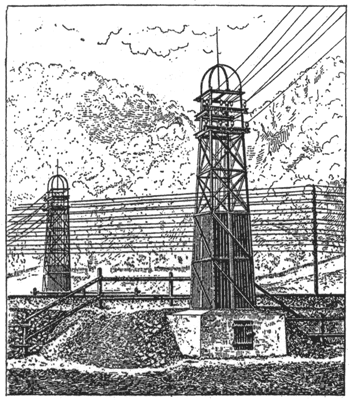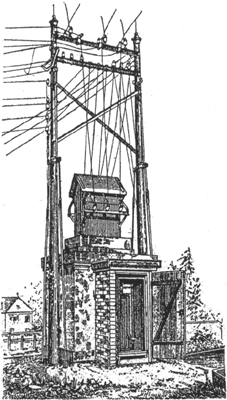[Trade Journal]
Publication: American Electrician
New York, NY, United States
vol. 10, no. 4, p. 158, col. 1-3
Power Transmission Lines in Switzerland. — Among the numerous Swiss installations for the electrical transmission of power, that in the neighborhood of the Lake of the Four Cantons presents some of the most interesting features, both on account of its magnitude and the novelty of the methods employed. The generating station is at Schwyz, where a natural fall of the river Muota is used as a source of power. Five horizontal turbines of 600 h.p. each are direct-coupled to three-phase alternators giving 8000 volts directly. The precautions against the destruction of the wheels by sand and gravel in the water, like the rest of the hydraulic features of the plant, are of the highest order and are very fully described by M. Henry Martin, in Le Genie Civil, from which the accompanying illustrations are taken. Perhaps the most interesting part of the installation is the line work. This is all aerial, bare copper wires being used throughout for both primary and secondary voltages. The lines extend to sixteen towns at present, and later will be built to Lucerne, 22 miles away. The longest line now operated is about 10 miles in length. Pine poles of various lengths are used, the insulators being of porcelain, double petticoated, 6 ins. high and 4 ins. in diameter and weighing about 5 1/2 lbs. These are attached to the pole by a hook-shaped iron bracket which goes through the pole to a nut on the opposite
 |
| High-Tension Lines Crossing A Railway. |
side. Each pole tip carries a cast iron head from which a copper point projects, the whole being earthed through a stout bi-metallic wire. At crossings over ordinary roads a double pole is planted at each side and a net of stout steel wires constructed from pole to pole under and about the three high tension conductors, so that if one of them breaks it cannot possibly fall into the road. At railway crossings a still more elaborate arrangement is used. Towers are built on each side of the tracks and a tunnel under the railway connects them.
 |
| A Swiss Transformer Sub-Station. |
The conductors come down through the central part of the towers and are led through the tunnel on insulators attached to its masonry roof. The lower parts of the towers are of iron plate. Sub-stations are uniform in construction, and consist of a vaulted structure of concrete, about 8 x 10 ft. in plan and 8 ft. high. This is surmounted by a sheet iron chimney for the conductors. On each side of the structure is erected a pole, the two being connected above by an iron beam carrying the insulators. Three transformers are in each sub-station, their connections being the usual triangle. They are wound to give 240 volts in each phase of the secondary, A peculiarity of this installation is that lights are operated from one side of the three-phase system, this being consequently unbalanced. The transformer from whose secondary lights are to be fed is, of course, larger than the other two in the same sub-station, and is provided with a terminal from the middle of its secondary coil. The lighting circuits are three-wire, with 120 volts between each side and the neutral. The whole installation, complete with water power developments, station, lines, and rights of way cost only [dollar:$160] per h.p. Power is sold at prices ranging between [dollar:$26] and [dollar:$56] per year, and 16-c.p. incandescent lamps are supplied with current at [dollar:$4.40] a year.
